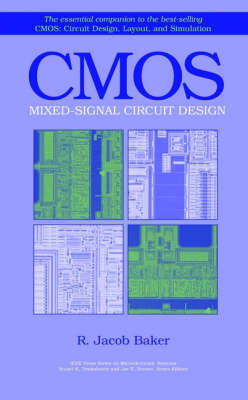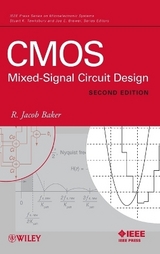
CMOS
John Wiley & Sons Inc (Verlag)
978-0-471-22754-0 (ISBN)
- Titel ist leider vergriffen;
keine Neuauflage - Artikel merken
This work is an important continuation to "CMOS: Circuit Design, Layout, and Simulation". The power of mixed-signal circuit designs, and perhaps the reason they are replacing analog-only designs in the implementation of analog interfaces, comes from the marriage of analog circuits with digital signal processing. This book builds on the fundamental material in the author's previous book, "CMOS: Circuit Design, Layout, and Simulation", to provide a solid textbook and reference for mixed-signal circuit design. The coverage is both practical and in-depth, integrating experimental, theoretical, and simulation examples to drive home the why and the how of doing mixed-signal circuit design.
Some of the highlights of this book include: a practical/theoretical approach to mixed-signal circuit design with an emphasis on oversampling techniques; an accessible and useful alternative to hard-to-digest technical papers without losing technical depth; coverage of delta-sigma data converters, custom analog and digital filter design, design with submicron CMOS processes, and practical at-the-bench deadbug prototyping techniques; and hundreds of worked examples and questions covering all areas of mixed-signal circuit design. A helpful companion Web site provides worked solutions to textbook problems, SPICE simulation netlist examples, and discussions concerning mixed-signal circuit design.
Preface to Volume II. Chapter 30: Data Converter Modeling. 30.1 Sampling and Aliasing: A Modeling Approach. 30.1.1 Impulse Sampling. 30.1.2 The Sample and Hold. 30.2 SPICE Models for DACs and ADCs. 30.2.1 The Ideal DAC. 30.2.2 The Ideal ADC. 30.3 Quantization Noise. 30.3.1 Viewing the Quantization Noise Spectrum Using Simulations. 30.3.2 Quantization Noise Voltage Spectral Density. Chapter 31: Data Converter SNR. 31.1 Data Converter SNR: An Overview. 31.1.1 Effective Number of Bits. 31.1.2 Clock Jitter. 31.1.3 A Tool: The Spectral Density. 31.2 Improving SNR Using Averaging. 31.2.1 Using Averaging to Improve SNR. 31.2.2 Decimating Filters for ADCs. 31.2.3 Interpolating Filters for DACs. 31.2.4 Bandpass and Highpass Sinc Filters. 31.3 Using Feedback to Improve SNR. 31.3.1 The Discrete Analog Integrator. 31.3.2 Modulators. Chapter 32: Noise Shaping Data Converters. 32.1 Noise Shaping Fundamentals. 32.1.1 SPICE Models. 32.1.2 First Order Noise Shaping. 32.1.3 Second Order Noise Shaping. 32.2 Noise Shaping Topologies. 32.2.1 Higher Order Modulators. 32.2.2 Multibit Modulators. 32.2.3 Cascaded Modulators. 32.2.4 Bandpass Modulators. Chapter 33: Submicron CMOS Circuit Design. 33.1 Submicron CMOS: Overview and Models. 33.1.1 CMOS Process Flow. 33.1.2 Capacitors and Resistors. 33.1.3 SPICE MOSFET Modeling. 33.2 Digital Circuit Design. 33.2.1 The MOSFET Switch. 33.2.2 Delay Elements. 33.2.3 An Adder. 33.3 Analog Circuit Design. 33.3.1 Biasing. 33.3.2 Op Amp Design. 33.3.3 Circuit Noise. Thermal Noise. The Spectral Characteristics of Thermal Noise. Noise Equivalent Bandwidth. MOSFET Noise. Noise Performance of the Source Follower. Noise Performance of a Cascade of Amplifiers. DAI Noise Performance. Chapter 34: Implementing Data Converters. 34.1 R 2R Topologies for DACs. 34.1.1 The Current Mode R 2R DAC. 34.1.2 The Voltage Mode R 2R DAC. 34.1.3 A Wide Swing Current Mode R 2R DAC. 34.1.4 Topologies Without an Op Amp. 34.2 Op Amps in Data Converters. 34.2.1 Op Amp Gain. 34.2.2 Op Amp Unity Gain Frequency. 34.2.3 Op Amp Offset. 34.3 Implementing ADCs. 34.3.1 Implementing the S/H. 34.3.2 The Cyclic ADC. 34.3.3 The Pipeline ADC. Chapter 35: Integrator Based CMOS Filters. 35.1 Integrator Building Blocks. 35.1.1 Lowpass Filters. 35.1.2 Active RC Integrators. 35.1.3 MOSFET C Integrators. 35.1.4 g[subscript m] C (Transconductor C) Integrators. 35.1.5 Discrete Time Integrators. 35.2 Filtering Topologies. 35.2.1 The Bilinear Transfer Function. 35.2.2 The Biquadratic Transfer Function. 35.3 Filters using Noise Shaping. Chapter 36: At the Bench. 36.1 A Push Pull Amplifier. 36.2 A First Order Noise Shaping Modulator. 36.3 Measuring 1/f Noise. 36.4 A Discrete Analog Integrator. 35.5 Quantization Noise. Index. About the Author.
| Erscheint lt. Verlag | 4.7.2002 |
|---|---|
| Reihe/Serie | IEEE Press Series on Microelectronic Systems | Wiley-Interscience |
| Zusatzinfo | illustrations |
| Verlagsort | New York |
| Sprache | englisch |
| Maße | 160 x 255 mm |
| Gewicht | 850 g |
| Einbandart | gebunden |
| Themenwelt | Technik ► Elektrotechnik / Energietechnik |
| ISBN-10 | 0-471-22754-4 / 0471227544 |
| ISBN-13 | 978-0-471-22754-0 / 9780471227540 |
| Zustand | Neuware |
| Haben Sie eine Frage zum Produkt? |
aus dem Bereich



